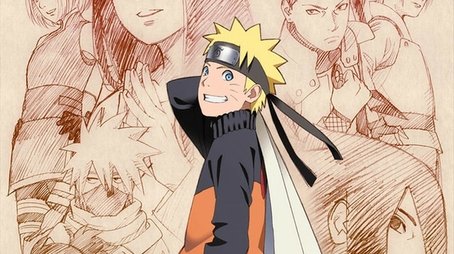
Ask Your Own Question
What is the plot?
Naruto Shippūden begins with Naruto Uzumaki returning to the Hidden Leaf Village after two and a half years of training with Jiraiya. He reunites with his friends, including Sakura Haruno and Kakashi Hatake. The village is still recovering from the attack by the Akatsuki, a criminal organization seeking to capture tailed beasts. Naruto is determined to become stronger to protect his friends and fulfill his dream of becoming Hokage.
The first major arc involves the rescue of Gaara, the Kazekage, who has been kidnapped by the Akatsuki. Naruto, Sakura, and Kakashi team up with Gaara's village allies, including Kankuro and Temari. They confront the Akatsuki members, Deidara and Sasori. In a fierce battle, Sasori is defeated by Sakura and Chiyo, an elder from the Sand Village. Naruto faces Deidara, who uses explosive clay in a high-stakes fight. Ultimately, Naruto's determination and new abilities allow him to help defeat Deidara, and they rescue Gaara.
After the rescue mission, the story shifts to the Akatsuki's plans to capture all the tailed beasts. The next significant arc focuses on the introduction of the Akatsuki member Hidan, who possesses immortality and a deadly curse technique. Asuma Sarutobi, a member of Team 10, confronts Hidan and his partner Kakuzu. In a brutal battle, Asuma is killed by Hidan, which deeply affects his team, especially Shikamaru Nara. Fueled by grief and anger, Shikamaru devises a plan to avenge Asuma. He leads a team to confront Hidan and Kakuzu, ultimately defeating them through a clever strategy that involves using Hidan's own immortality against him.
The narrative then shifts to the introduction of the Uchiha clan's history and the significance of the Sharingan. Sasuke Uchiha, driven by a desire for revenge against his brother Itachi, leaves the village to seek power. Naruto and Sakura attempt to bring him back, leading to a confrontation with Orochimaru, who has been manipulating Sasuke. The battle culminates in a fierce fight between Naruto and Sasuke, where Naruto tries to reach out to his friend, but Sasuke ultimately chooses to pursue his own path.
As the story progresses, the Akatsuki continues to capture tailed beasts. The next major arc involves the capture of the Three-Tails and the introduction of new characters, including the enigmatic Pain, the leader of the Akatsuki. Pain's philosophy and his connection to Naruto become central themes. The village faces a devastating attack from Pain, who uses his Rinnegan abilities to wreak havoc. Naruto, having trained with Fukasaku and Shima at Mount Myoboku, learns Sage Mode and prepares to confront Pain.
In a climactic battle, Naruto faces Pain in the ruins of the Hidden Leaf Village. The fight showcases Naruto's growth and mastery of Sage Mode, as he battles Pain's six bodies. The emotional stakes rise as Naruto learns about Pain's tragic past and his motivations for seeking peace through destruction. After an intense confrontation, Naruto ultimately defeats Pain, but instead of killing him, he chooses to understand him and offers a path to peace. This decision leads to a significant change in the village's perception of Naruto.
Following the battle with Pain, the story delves into the aftermath and the rebuilding of the village. Naruto's actions earn him respect, and he begins to gain recognition as a hero. However, the threat of the Akatsuki remains, and the focus shifts to the remaining members, including Tobi, who reveals himself as the true mastermind behind the organization. Tobi's plans involve the resurrection of the Ten-Tails and the implementation of the Infinite Tsukuyomi, a plan to trap the world in an illusion.
The narrative escalates as the Fourth Great Ninja War is declared. The Allied Shinobi Forces are formed, uniting various villages against the Akatsuki. Key battles occur, showcasing the strength and abilities of various characters, including the return of past heroes like the Fourth Hokage, Minato Namikaze, who is revealed to be Naruto's father. The war brings significant losses, including the deaths of beloved characters, and tests the resolve of the shinobi alliance.
As the war progresses, Naruto and Sasuke's paths converge once again. They confront Tobi and the resurrected Madara Uchiha, who seeks to dominate the world. The battles are intense, with Naruto and Sasuke working together, showcasing their growth and the bond they share. The climax of the war leads to the revelation of the true nature of the Sage of Six Paths and the origins of chakra.
In the final confrontation, Naruto and Sasuke face Kaguya Otsutsuki, the progenitor of chakra. The battle is complex, involving time-space manipulation and the combined efforts of their allies. After a grueling fight, they manage to seal Kaguya away, but not without significant sacrifices and revelations about their own destinies.
The story concludes with Naruto achieving his dream of becoming Hokage, uniting the villages and bringing peace to the ninja world. Sasuke, having found his own path, decides to wander the world to atone for his past. The series ends with a sense of hope and the promise of a new era for the shinobi world, as Naruto and his friends look toward the future.
What is the ending?
In the ending of Naruto Shippūden, Naruto Uzumaki finally achieves his dream of becoming Hokage after a long and arduous journey filled with battles, loss, and growth. The series concludes with a peaceful resolution, showcasing the bonds formed throughout the story and the legacy of the characters. The final scenes depict Naruto as an adult, happily married to Hinata Hyuga, and raising their children, Boruto and Himawari, while the village of Konohagakure thrives in peace.
As the final arc of Naruto Shippūden unfolds, the tension escalates with the Fourth Great Ninja War reaching its climax. The Allied Shinobi Forces, composed of various ninja from different villages, stand united against the formidable threat of Kaguya Otsutsuki and her plans to cast the Infinite Tsukuyomi, a genjutsu that would trap the entire world in an illusion.
Scene 1: The battlefield is chaotic, filled with the sounds of clashing jutsu and the cries of warriors. Naruto, Sasuke, Sakura, and Kakashi are at the forefront, fighting valiantly against Kaguya. The air is thick with desperation as they strategize to counter her overwhelming power. Naruto's determination shines through as he recalls his friends and the bonds that have strengthened him. He feels the weight of their hopes on his shoulders.
Scene 2: Kaguya, with her ethereal presence, manipulates dimensions, creating a surreal landscape that shifts and warps. The team struggles to keep up with her, but Naruto and Sasuke, having developed a deep bond through their shared experiences, synchronize their attacks. Their resolve is palpable; they are not just fighting for themselves but for the future of their world.
Scene 3: As the battle intensifies, Naruto taps into the power of the Sage of Six Paths, gaining new abilities that allow him to fight on par with Kaguya. The emotional stakes rise as he reflects on his journey, the friends he has lost, and the sacrifices made along the way. His inner strength is fueled by the memories of those who believed in him.
Scene 4: After a fierce struggle, Naruto and Sasuke manage to seal Kaguya away, but not without significant cost. The battle leaves them exhausted, and they are faced with the aftermath of their victory. The world is still in turmoil, and they must confront the consequences of the war.
Scene 5: The narrative shifts to the aftermath of the war. The shinobi world begins to rebuild, and Naruto, now recognized as a hero, is determined to bring peace to all villages. He is elected as the Seventh Hokage, fulfilling his lifelong dream. The scene is filled with celebration, but Naruto remains humble, understanding the responsibilities that come with his new title.
Scene 6: In a poignant moment, Naruto visits the memorial stone, reflecting on his fallen comrades, including Neji, who sacrificed himself during the war. The weight of loss is heavy on his heart, but he vows to honor their memories by protecting the peace they fought for.
Scene 7: The series concludes with a time skip, showing Naruto as an adult, married to Hinata Hyuga. They have two children, Boruto and Himawari. The village of Konohagakure is thriving, and Naruto is seen balancing his duties as Hokage with his role as a father. The final scenes depict a peaceful village, with Naruto smiling as he watches his children play, embodying the hope for a brighter future.
In the end, each main character finds their resolution: Sasuke embarks on a journey of redemption, seeking to atone for his past; Sakura becomes a skilled medical ninja, dedicated to helping others; Kakashi takes on a mentor role, guiding the next generation. The bonds forged through struggle and sacrifice resonate throughout the village, emphasizing the themes of friendship, perseverance, and the enduring spirit of the shinobi. The series closes on a note of hope, with the promise of a new generation carrying on the legacy of their predecessors.
Is there a post-credit scene?
In "Naruto Shippūden," there are no traditional post-credit scenes like those found in many modern films. However, the series does feature a few moments at the end of certain episodes that serve as light-hearted or humorous conclusions, often showcasing the characters in comedic situations or providing a brief glimpse into their daily lives.
One notable example occurs in the final episode, where the series concludes with a montage of various characters reflecting on their journeys and the bonds they have formed. This sequence is filled with nostalgia, showcasing key moments from the series, and it emphasizes themes of friendship, perseverance, and the passage of time. The emotional weight of the series culminates in this reflective moment, leaving viewers with a sense of closure and hope for the future of the characters they have come to love.
While these moments are not post-credit scenes in the traditional sense, they serve to enhance the overall narrative and provide a final emotional touch to the series.
What is the significance of Naruto's relationship with Sasuke throughout the series?
Naruto's relationship with Sasuke is central to the narrative of Naruto Shippūden. Initially, Naruto views Sasuke as a rival and a friend, motivated by his desire to bring him back to the village after Sasuke leaves to gain power from Orochimaru. This relationship is marked by Naruto's unwavering determination to save Sasuke from the darkness he is drawn into, reflecting Naruto's own struggles with loneliness and the desire for connection. As the series progresses, their bond deepens, showcasing themes of friendship, redemption, and the impact of choices. Naruto's emotional turmoil and growth are intricately tied to his interactions with Sasuke, culminating in their final confrontation and eventual reconciliation.
How does the Akatsuki organization influence the events of Naruto Shippūden?
The Akatsuki organization serves as the primary antagonistic force in Naruto Shippūden, significantly influencing the plot's progression. Comprised of rogue ninjas with their own agendas, the Akatsuki seeks to capture the Tailed Beasts to achieve their goal of world domination through the resurrection of the Ten-Tails. Each member has a unique backstory and motivation, adding depth to their characters. Their actions lead to major conflicts, including the capture of Gaara and the subsequent battles against various ninja villages. The Akatsuki's ideology challenges the protagonists, particularly Naruto, to confront their beliefs about peace and power, ultimately shaping the series' climax and resolution.
What role does Sakura Haruno play in Naruto Shippūden, and how does her character develop?
Sakura Haruno's role in Naruto Shippūden evolves significantly from her initial portrayal in the original Naruto series. Initially depicted as a love-struck girl with limited combat abilities, Sakura undergoes rigorous training under Tsunade, the Fifth Hokage, which enhances her skills as a medical ninja and a formidable fighter. Her character development is marked by her growing confidence and determination to protect her friends, particularly Naruto and Sasuke. Throughout the series, she grapples with her feelings for Sasuke, her desire to be strong, and her commitment to her team. Key moments, such as her confrontation with Sasori and her support during the Fourth Great Ninja War, highlight her transformation into a powerful and independent kunoichi.
What is the significance of the Uchiha clan's history and its impact on Sasuke's character?
The Uchiha clan's history is pivotal to understanding Sasuke Uchiha's character arc in Naruto Shippūden. The tragic massacre of the Uchiha clan by his brother Itachi creates a deep-seated desire for revenge within Sasuke, driving his actions throughout the series. This backstory reveals themes of betrayal, loss, and the quest for power. As Sasuke learns more about the truth behind Itachi's actions and the Uchiha's role in the village's history, his motivations shift from revenge to a more complex understanding of justice and redemption. The exploration of the Uchiha clan's legacy, including the curse of hatred and the cycle of vengeance, profoundly influences Sasuke's choices and relationships, particularly with Naruto.
How does the Fourth Great Ninja War affect the relationships between the main characters?
The Fourth Great Ninja War serves as a catalyst for significant character development and relationship dynamics in Naruto Shippūden. As various ninja villages unite against a common enemy, the war forces characters to confront their pasts, beliefs, and alliances. Naruto's leadership and determination inspire others, strengthening his bonds with allies like Sakura, Kakashi, and even former enemies like Gaara. The war also brings to light the complexities of relationships, such as Sasuke's evolving connection with Naruto and the reconciliation of past grievances among the ninja clans. The emotional stakes are heightened as characters face loss, sacrifice, and the harsh realities of battle, ultimately leading to a deeper understanding of friendship, loyalty, and the desire for peace.
Is this family friendly?
Naruto Shippūden, while primarily an action-adventure anime, does contain several elements that may be considered objectionable or upsetting for children or sensitive viewers. Here are some aspects to be aware of:
-
Violence and Battles: The series features intense battles with various forms of combat, including hand-to-hand fighting, weapon use, and the use of ninjutsu. Characters often sustain injuries, and there are scenes of bloodshed.
-
Death and Loss: Characters face significant loss throughout the series, including the deaths of friends and family members. These moments are often portrayed with emotional weight, showcasing grief and sorrow.
-
Emotional Trauma: Several characters deal with deep emotional issues, including abandonment, betrayal, and the struggle for acceptance. These themes can be heavy and may resonate strongly with sensitive viewers.
-
Dark Themes: The series explores themes of revenge, hatred, and the consequences of war. Some story arcs delve into the darker aspects of human nature and the impact of conflict on individuals and communities.
-
Mature Relationships: There are instances of complex relationships, including unrequited love and the emotional struggles that come with them. Some characters have backstories involving manipulation and betrayal.
-
Supernatural Elements: The presence of supernatural abilities and creatures may be unsettling for some viewers, particularly younger children who might find certain designs or concepts frightening.
While Naruto Shippūden is designed for a broad audience, these elements may require parental guidance for younger viewers or those who are particularly sensitive to such themes.











